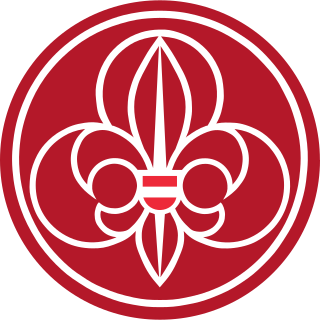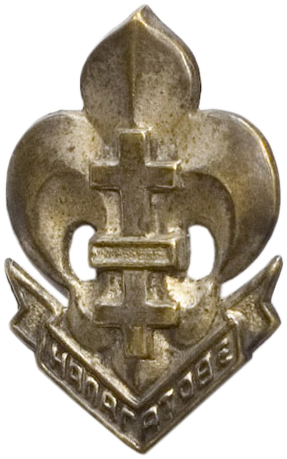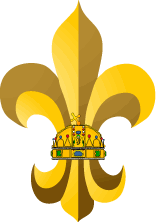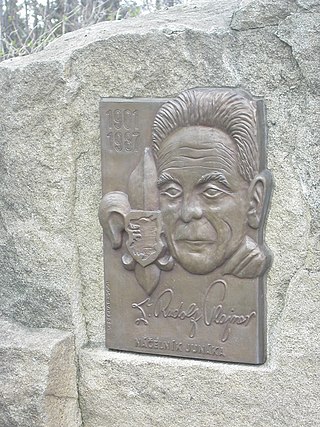
Czechoslovakia was a landlocked state in Central Europe, created in 1918, when it declared its independence from Austria-Hungary. In 1938, after the Munich Agreement, the Sudetenland became part of Nazi Germany, while the country lost further territories to Hungary and Poland. Between 1939 and 1945, the state ceased to exist, as Slovakia proclaimed its independence and Carpathian Ruthenia became part of Hungary, while the German Protectorate of Bohemia and Moravia was proclaimed in the remainder of the Czech Lands. In 1939, after the outbreak of World War II, former Czechoslovak President Edvard Beneš formed a government-in-exile and sought recognition from the Allies.

The National Front was a political coalition created in 1943 serving as united front of political parties for liberation of Czechoslovakia, after 1948 organized solely by the Communist Party of Czechoslovakia. It was the vehicle for control of all political and social activity by the Communist Party of Czechoslovakia (KSČ). It was also known in English as the National Front of Czechs and Slovaks.
With the collapse of the Austria-Hungary at the end of World War I, the independent country of Czechoslovakia was formed as a result of the critical intervention of U.S. President Woodrow Wilson, among others.

Junák – český skaut, is the internationally recognized organization of Scouts and Guides of the Czech Republic. Founded in 1911, Junák – český skaut is the largest organisation of children and youth in the nation, with a membership of 73,315.

Pfadfinder und Pfadfinderinnen Österreichs is the largest Scouting and Guiding organization in Austria and the only one approved by World Association of Girl Guides and Girl Scouts (WAGGGS) and the World Organization of the Scout Movement (WOSM). The association claims more than 300 troops with more than 85,000 Scouts nationwide. WOSM and WAGGGS give quite smaller membership values for the PPÖ: 27,274 members in WOSM and 10,508 members in WAGGGS.

The Czechoslovak Socialist Republic, known from 1948 to 1960 as the Czechoslovak Republic, Fourth Czechoslovak Republic, or simply Czechoslovakia, was the Czechoslovak state from 1948 until 1989, when the country was under communist rule, and was regarded as a satellite state in the Soviet sphere of interest.

Magyar Cserkészszövetség, the primary national Scouting organization of Hungary, was founded in 1912, and became a member of the World Organization of the Scout Movement in 1922 and again after the rebirth of Scouting in the country in 1990. The coeducational Magyar Cserkészszövetség had 12,937 members in 2021.

Slovenský skauting, is the primary national Scouting and Guiding organization of Slovakia. Currently has around 7000 members. With 3,157 Scouts and about 3,000 Guides. Slovenský Skauting is the largest youth organization in Slovakia and a member of both the World Organization of the Scout Movement and the World Association of Girl Guides and Girl Scouts.

Scouting Nederland is the national Scout organisation of the Netherlands with approximately 110,000 members (53,324 male and 54,663 female, 87,000 youth members, as of 2010.

The Scout movement in Belarus consisted of 1200 members when it joined the World Organization of the Scout Movement (WOSM) in 2010. There are at least five nationwide associations as well as some regional associations. In addition, there were at one time Scouts-in-Exile in metropolitan areas of the United States, and there are presently international Scout units in Belarus.

Girl Guides in Hungary are served by the Association of Hungarian Girl Guides, with 512 members as of 2003. Founded in 1919, the girls-only organization became a full member of the World Association of Girl Guides and Girl Scouts in 1928, and an associate member again in 1993. It regained full membership in 2008.

Külföldi Magyar Cserkészszövetség is a Scouts-in-Exile organization created for youth of Hungarian descent. Scouting makes it possible for young men and women to learn more about their Hungarian heritage, language and culture. The organization is dedicated to carrying out its obligations at four levels: God, their adopted countries, their fellow man and the Hungarian nation. The Boy Scout and Girl Scout units meet in conjunction with Hungarian weekend schools, which in many instances they also operate.

The Scout and Guide movement in the Czech Republic is served by

The Scout and Guide movement in Hungary is served by
The Czech and Slovak Legion, also known as the Czechoslovak Legion, was a military unit formed in the Second Polish Republic after Germany occupied Czechoslovakia in March 1939. The unit took symbolic part in the defence of Poland during the German invasion on 1 September 1939.

Dr. Rudolf Plajner was declared the Chief Scout of the newly unified Czech Scouts and Guides association called Junák, after its inception on January 22, 1939. Junák was abolished by force and Scouting prohibited by German State Secretary Karl Hermann Frank during the Nazi occupation of Czechoslovakia on October 28, 1940. After World War II, the association was reborn. His function was confirmed at the third Junák council or meeting (cs:sněm) in 1968, and served in this function until the end of his life.

Czechoslovak resistance to the German occupation of the Protectorate of Bohemia and Moravia during World War II began after the occupation of the rest of Czechoslovakia and the formation of the protectorate on 15 March 1939. German policy deterred acts of resistance and annihilated organizations of resistance. In the early days of the war, the Czech population participated in boycotts of public transport and large-scale demonstrations. Later on, armed communist partisan groups participated in sabotage and skirmishes with German police forces. The most well-known act of resistance was the assassination of Reinhard Heydrich. Resistance culminated in the so-called Prague uprising of May 1945; with Allied armies approaching, about 30,000 Czechs seized weapons. Four days of bloody street fighting ensued before the Soviet Red Army entered the nearly liberated city.

The Hungarian Scout Association in Slovakia is the Scouting organization of Hungarians in Slovakia. Currently, there are about 50 Scout groups with around 1,500 active Scouts.

Czechoslovak National Council was an organization founded by Czech and Slovak émigrés during World War I to liberate their homeland from Austria-Hungary. During the closing weeks of the war, the Czechoslovak National Council was formally upgraded to a provisional government and its members were designated to hold top offices in the First Czechoslovak Republic.
Operation Jizerka was the cover name for a Czechoslovak StB operation in 1949 against memebrs of Junák. It included an attack by StB and SNB units against the camp of Železný Brod scouts on the slopes of the Vlašský hřeben, which is part of the Vysoký jizerský hřbet, which claimed two lives, and the subsequent trial.

















